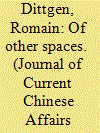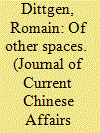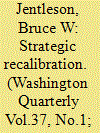|
|
|
Sort Order |
|
|
|
Items / Page
|
|
|
|
|
|
|
| Srl | Item |
| 1 |
ID:
137197


|
|
|
|
|
| Summary/Abstract |
The burgeoning interstate relation between China and Nigeria is in fact hiding the vulnerable condition of transnational Chinese petty entrepreneurship. Small-scale Chinese entrepreneurs in Nigeria are faced with everyday corruption practised by both Nigerian authorities and ordinary Nigerian people, the dominance of self-interest over cohesion and mutual support among the Chinese compatriots, and variations in state policies due to dynamic and changing interstate relations. To overcome their position of weakness, small-scale Chinese entrepreneurs strategize their interactions with both Nigerian and Chinese nationals. Informality is a characteristic of such interactions. Economic informality is primarily embodied in the documentation service businesses that are indebted to those popular corrupt practices in Nigeria; while social informality takes place in cyberspace. Interaction via the Internet among Chinese involved in Chinese–Nigerian businesses helps small-scale Chinese entrepreneurs to cope with fluctuations in interstate links at the macro-level and to develop a sense of community.
|
|
|
|
|
|
|
|
|
|
|
|
|
|
|
|
| 2 |
ID:
137195


|
|
|
|
|
| Summary/Abstract |
Chinese economic activities in Africa have gained increased visibility in parallel to the recent acceleration of Sino-African relations. This paper, which is framed from a geographical perspective that is often absent or neglected in studies covering China–Africa, focuses on the spatial forms and dynamics. It depicts the way in which two contrasting Chinese economic entities – a state-owned company in Chad and privately owned commercial malls in Johannesburg, South Africa – engage with their respective host environments. While drawing on concepts of “liminality” as well as “heterotopias”, I argue that the modalities of the Chinese footprint are characterised both by closure and interaction, creating a dynamic tension that produces its own set of unique practices. This ambivalence between enclave and active linkages with host societies is not only perceivable from a spatial point of view, but also emerges with regard to economic strategies. In the midst of a transitional period, along with a launching and a consolidating phase, the Chinese economic entities in both case studies show signs of change in terms of behaviour and territorial foothold.
|
|
|
|
|
|
|
|
|
|
|
|
|
|
|
|
| 3 |
ID:
137196


|
|
|
|
|
| Summary/Abstract |
Chinese economic activities in Africa have gained increased visibility in parallel to the recent acceleration of Sino-African relations. This paper, which is framed from a geographical perspective that is often absent or neglected in studies covering China–Africa, focuses on the spatial forms and dynamics. It depicts the way in which two contrasting Chinese economic entities – a state-owned company in Chad and privately owned commercial malls in Johannesburg, South Africa – engage with their respective host environments. While drawing on concepts of “liminality” as well as “heterotopias”, I argue that the modalities of the Chinese footprint are characterised both by closure and interaction, creating a dynamic tension that produces its own set of unique practices. This ambivalence between enclave and active linkages with host societies is not only perceivable from a spatial point of view, but also emerges with regard to economic strategies. In the midst of a transitional period, along with a launching and a consolidating phase, the Chinese economic entities in both case studies show signs of change in terms of behaviour and territorial foothold.
|
|
|
|
|
|
|
|
|
|
|
|
|
|
|
|
| 4 |
ID:
133780


|
|
|
|
|
| Publication |
2014.
|
| Summary/Abstract |
The release of the Obama administration's 2014 National Security Strategy comes amidst increasing criticism of its strategic savvy. Some are rank partisan, some Monday-morning quarterbacking. Some, though, reflect the intensifying debate over the optimal U.S. foreign policy strategy for our contemporary era.
At one end of the debate are those advocating retrenchment, who see limited global threats on one hand and prioritize domestic concerns on the other-be they the budget-cutting of the Tea Party right or the nation-building-at-home of the progressive left. At the other end are neoconservatives and others pushing for re-assertiveness. This is based on a bullish assessment of U.S. power and the contention that it still is both in the U.S. national interest and that of world order for the United States to be the dominant nation. While retrenchment overestimates the extent to which the United States can stand apart, re-assertiveness overestimates the extent to which it can sit atop.
|
|
|
|
|
|
|
|
|
|
|
|
|
|
|
|
| 5 |
ID:
086167


|
|
|
|
|
| Publication |
2009.
|
| Summary/Abstract |
Because of the importance attached to military operations to destroy al-Qaeda, Pakistan is often viewed in the context of Afghanistan. As a result, events in Pakistan are usually assessed in terms of their effect on US objectives for Operation Enduring Freedom and on the operations of NATO's International Security Assistance Force. Their implications for Pakistan as a whole have been neglected and sometimes poorly analysed. But the well-being and stability of Pakistan is of supreme importance in its own right. This importance needs to be reflected in a sound and coherent strategy towards the country. The formulation of such a strategy requires an informed understanding of Pakistan's history; social, political and economic dynamics; and key personalities and influences. And the strategy needs to be underpinned by resources which are commensurate with the importance of the interests to be protected and advanced. Unfortunately, the customary means of acquiring real-time knowledge of events and personalities - diplomacy, media, commercial and other contacts - have been and still are impeded by the hazardous security situation in much of the country. Without a good understanding, actions taken for tactical purposes may have negative strategic consequences which outweigh the hoped-for benefits, as has occurred on several recent occasions.
The challenges in southwestern Asia need to be considered in three separate but related contexts: Afghanistan, the Afghan-Pakistani tribal belt, and Pakistan. In the present conjuncture, Pakistan is arguably the most important of the three. With nuclear weapons and a huge army, a population over five times that of Afghanistan, and simultaneous security, political and economic crises, it now seems less able, without outside help, to muddle through its challenges than at any time since its war with India in 1971.
|
|
|
|
|
|
|
|
|
|
|
|
|
|
|
|
|
|
|
|
|